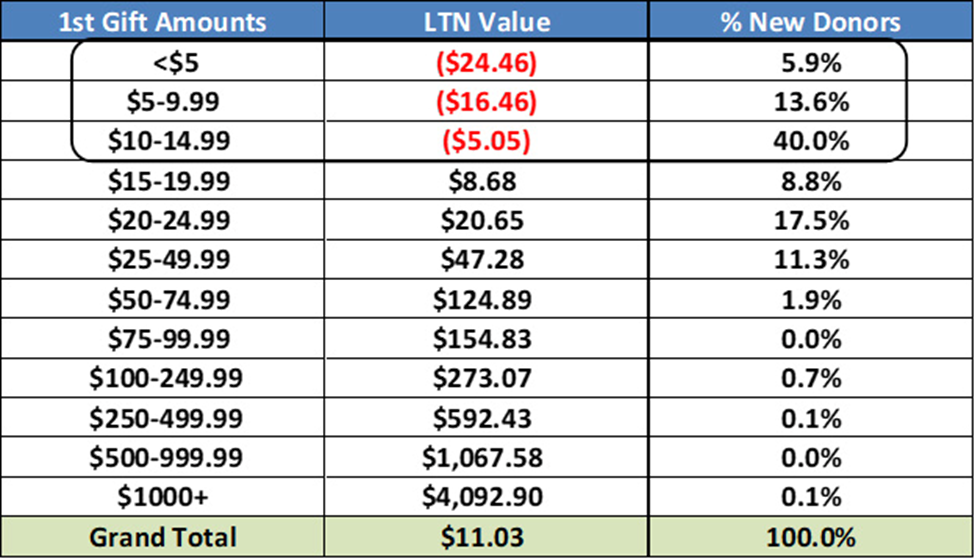Let’s be honest: New donor acquisition is tough.
Year after year, you need to find new prospects, build strategies to engage with them and motivate them to support your mission.
That alone is difficult, but in recent years we’ve all seen the added challenges of supply chain, inflation, declining donor response and the loss of trust in nonprofits.
It’s enough to make you want to give up, but you know you can’t. No matter how you look at it, cutting acquisition doesn’t work.
That’s why we need a better approach to acquisition, and we’ve developed one with the use of LTN.
LTN vs. LTV: What’s the difference?
Agencies and vendors across the nonprofit fundraising industry have been using lifetime value (LTV) as a metric for targeting donors for longer than I can remember. LTV is simply the amount of money a donor is projected to give to an organization over their lifetime.
For some donors, this is a short cycle of a few years before they lapse and never return. For others, this number builds over time as a wealthier donor develops a strong affinity for the organization and its mission.
Thus, the idea is that you want to target the latter group—those with a higher LTV—which will lead to better long-term results.
The problem is that LTV doesn’t take cost into account. How much are you spending year over year to retain those donors? And are those investments worth it?
That’s where LTN comes in. LTN stands for long-term net, and it calculates both the revenue and the cost of a donor relationship over a five-year period from the point of acquisition.
LTN helps nonprofits invest more wisely, bringing in high-value donors and achieving a higher net revenue return. With LTN, we can optimize acquisition investment down to list selection by looking at aspects like age, seasonality, ZIP cluster, channel and more.
LTV won’t get you where you want to go in today’s environment. LTN is the future.
How LTN helps build stronger donor files
In the chart below, this organization focused its acquisition on donor volume. Their lower gift array helped bring in more donors, but when we look at LTN, we see that donors with a first gift under $15 had a negative value over five years.
To put that another way: They lost money on 59.5% of the new donors they brought in.
That is not a sustainable long-term strategy. Just look at how that affects the grand total. Over the course of five years, each new donor was worth only $11.03 in net revenue. Ouch!

RKD recently helped a large national nonprofit organization that mails 37 million pieces each year turn around their acquisition program through the use of LTN.
When we began our partnership, this organization’s acquisition was highly unprofitable—worse than the chart above. Our LTN analysis showed that less than 10% of the lists being mailed met the ROI threshold needed to produce viable long-term net revenue for the program.
Their previous list broker was focused on response over value and on minimizing list costs. While keeping costs low is a good thing, these lower-cost lists were consistently underperforming and overutilized.
With a shrinking donor universe, the organization set aggressive new donor goals to offset attrition. Over the course of three years, we implemented the following tactics and strategies to transform their direct mail acquisition program:
- Year 1: We conducted significant list and package testing to identify lists that could meet the target ROI threshold, bringing on more valuable donors at an acceptable response rate. We also used adjusted co-op models to eliminate low-value donors.
- Year 2: We continued to re-test lists meeting the ROI criteria. In addition, our team rebuilt co-op models using data and learnings from Year 1.
- Year 3: RKD rolled out the top-performing lists and co-op models from the prior two years, resulting in exponential revenue growth. In addition, we tested our new lapsed recapture models.
By the end of Year 3, more than 75% of the lists being mailed had exceeded the ROI threshold to generate positive LTN. This has transformed their new donor file, impacting the entire program.
Thanks to our optimized list approach with LTN, this organization experienced:
- 28% increase in first gifts of $25 or more
- 20% lift in new donor average gift size
- 11% increase in overall direct mail donor retention
- 27% rise in direct mail gross revenue
At a time when nonprofits everywhere are looking for ways to minimize risk and maximize revenue, LTN can help you revolutionize your fundraising. Through precision targeting, you can reach high-value donors and end the churn-and-burn cycle.
If you’re looking to accelerate your growth, you must address this now. Those who don’t will face bigger problems in the future.
Learn more:
- Why cutting acquisition is a terrible idea
- We tested reactivating newly lapsed donors in acquisition. Here’s what happened.
- How to optimize your digital donor acquisition






Leave a comment: